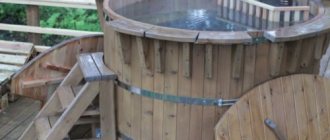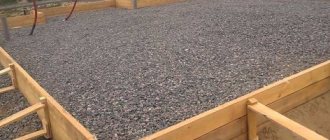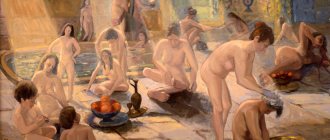Sento is a unique part of Japanese culture and one of the best ways to combat the winter cold. Sento baths in Japan still have their regular fans: there is no fuss, the prices are quite affordable, and most of the visitors are old acquaintances. Most likely, the most important thing about sento for locals is the opportunity to completely relax, relieve stress and even meet new people. What is sento for Japan? What are the rules of behavior, use and features of a traditional Japanese public bath?
You don't have to take anything with you!
To demonstrate how to use Japanese baths, we went to Takaraya, a sento located in the Adachi district of Tokyo. Seeing this splendor of the Showa era (1926-1986), you freeze for a minute before deciding to lift the noren curtain in front of the entrance - but there is no need to be shy, now we will tell you how to behave here. It’s great if you have clean clothes, shampoo, conditioner, soap and other bath accessories with you. However, even if they are not there, everything is in order, you can go in without anything. So here we go.
Behind the noren curtain reigns the spirit of old Japan from the Showa era
It’s convenient if you have a bag or bag with you where you can put wet towels, soap and other supplies.
How to visit ofuro?
Here are the main stages of visiting a Japanese bath:
1. The person undresses, remaining in cotton underwear, which is given to each visitor. Next, it is immersed in a barrel, where water has already been poured, the temperature of which is 35°C. The average duration of stay in the barrel is 3–5 minutes.
Attention! The water level should be just below the heart line so as not to cause overheating and not disrupt the thermal regime.
2. After ablution, a person goes to the furaco font, where the water temperature is 10 °C higher. The duration of stay in the barrel is about 7–9 minutes.
3. Next, the visitor changes the barrels, taking a place in the dry one, where sawdust and essential oils are already mixed. Sawdust actively massages the body, starting from the fingertips and ending with the area under the breasts. The average duration of stay in this barrel is 30 minutes.
4. The fourth stage of the ceremony is laying on stones that are preheated to 45–50 °C, respectively. The stones actively massage the body. The duration of stay on the pebbles is about 5–10 minutes.
5. The final stage of visiting the authentic Ofuro bathhouse is a cool shower and several cups of warm tea.
Modern wellness centers offer ofuro lovers a manicure or pedicure to logically complete the procedure and deliver maximum pleasant sensations.
To experience all the benefits of sento and ofuro, you don’t need to go to the land of the rising sun. Visit these steam rooms in Moscow or St. Petersburg, where you will receive service no worse than in Japan!
We take off our shoes, pay and go to the locker room
As we pass behind the noren curtain, in the hallway (genkan) we see shoe cabinets. If the wooden key sticks out in the lock, the cell is free. We put the shoes inside, close it and take out the die - the cell is closed. At Takaraya, you keep the key die until you leave, and in some sentos the key is deposited at the reception desk.
It is worth keeping in mind that very large shoes may not fit in the cell
The fee for using the sento, which we pay at the reception counter, throughout Tokyo is 460 yen. If necessary, you can buy a bath set here. Next we go to the locker room - the men's and women's sections have their own entrances, curtained with noren curtains. Those sento where there is a place for the steward on a raised platform (bandai) also work in much the same way. There are often sentos in which the entrances to the building are made separate for men and women.
At the reception desk you can buy a razor, toothbrush, towel
Elements of a traditional Japanese bath
What is sento?
Approximately in the 5th century, mashiburo baths were invented in Japan. These structures could only be used by clergy; ordinary people were not allowed there. Mashiburo belonged to steam baths. Centuries later, in the 12th century, baths arose, to which all people had access.
Sento bath
Such baths were of a public nature and were built by Buddhist monks at temples
The peculiarities of the local climate were taken into account. In winter, the air temperature could drop to forty degrees below zero
People did not have warm clothes, and their homes were not heated sufficiently, and the sea wind penetrated right through them. This led to the need for heating, for which the bathhouse was used. In urban settings, establishments were built that were used, in addition to bathing procedures, for communication between residents. Moreover, at the beginning of the development of this tradition, washing women and men took place in one place. To carry out the washing procedure, visitors were given a basin filled with hot water upon entry. Having received such simple accessories, the visitor went to wash. To reduce heat loss, the entrance was built very low. The public bath in Japan is called sento. Wealthy Japanese could afford to build a bathhouse on their estates.
Japanese bath
It is noteworthy that before the advent of sento, the resourceful inhabitants of Japan used natural thermal springs to achieve the same goal. In addition to the fact that a person warmed up in the spring, he was also saturated with beneficial mineral salts. Such natural baths are called osen.
Currently, a sento is a large room in which representatives of different sexes wash separately. They are equipped with taps that supply water at different temperatures. The visitor cleans himself using soap and a washcloth, and then goes to a special room.
In some cases, sento may not allow foreigners or people with tattoos on their bodies, which is contrary to religious beliefs.
Characteristics of ofuro
Japanese baths are barrels
Having completed the washing procedure, the person went to a room where there were large barrels made of wood. They are installed on the stove. According to the Japanese, only the appropriate attitude helps to achieve the required therapeutic effect during the bath procedure. The barrels are filled with water, the temperature of which is 50 degrees Celsius, which does not frighten the Japanese. During the procedure, a person is not completely immersed in water, but sits chest-deep in hot water. In this case, a massage is performed on the part of the body and face that is not immersed in water. The duration of this part of the bath activities lasts about 7 minutes. If the visitor’s health allows, they can increase to 15 minutes. After this time, they leave the barrel and wipe themselves dry.
After this procedure, the person moves to the next barrel, which is called furaco. The contents of this container consist of cedar sawdust with the addition of aromatic oils and medicinal herbs. Warming up the sawdust allows the body to warm up, which is accompanied by the opening of skin pores. When this state is achieved, all the beneficial substances contained in plants penetrate the body. This helps to rejuvenate the skin and relax the body as a whole, which increases a person’s vitality.
Ofuro baths in modern times
The next step is to dive into the next barrel containing heated sea pebbles. This event has a healing effect on the spine and has an effect equivalent to a full body massage.
After leaving the third and final barrel, a body massage can be performed, after which you should rest. The bath procedures end with a tea ceremony.
In the locker room we completely undress and go to the bath room.
In the locker room we take off our clothes and underwear, put them in a locker along with our other things and the key to the shoe locker. We put the key to the locker on our wrist, and, covering ourselves with a small towel, we go to the bath room, taking with us the necessary accessories - shampoo, razor, etc. There is usually a lot of steam and high humidity in the bath room, so we close the door tightly behind us.
The locker is locked, but you shouldn’t put valuables there; it’s better to leave them for storage at the reception desk
History ofuro
It is believed that the first ofuros were built at the dawn of Buddhism. The Japanese did not use soap as a matter of principle, since it was necessary to kill animals to make it. Therefore, in order to wash well, it was necessary to swim in hot water. Also, the emergence of the Japanese steam room is associated with a specific climate, when, due to high humidity, people often warmed themselves with improvised means. One of these were barrels filled with sawdust. To keep warm, the barrels were covered with lids with holes for the guest's head.
The Japanese believe that ofuro is the best solution for cleansing the soul and body.
The Japanese steam room combines four elements at once: air, water, fire and earth. And that is why inside such a structure it is possible to achieve absolute harmony of soul and body.
Japanese women consider visiting ofuro a guarantee of youth and slimness. Remember how beautiful, well-groomed and slender Japanese women are, who have been instilled with the culture of bathing in healing barrels and caring for their appearance with the help of miraculous steam since childhood. Perhaps the Ofuro bathhouse will become your tool for achieving youth and beauty?
We wash ourselves clean and go into the pool
To the side of the entrance we take a bathroom chair and a washcloth and go to the washing areas and sit down in front of the tap. You should wash yourself thoroughly before entering the communal pool. Try to wash so that the water from your shower does not get on other people. If the tap water is too hot, dilute it with cold water.
Before entering the pool, you need to wash yourself well. If you leave the wash area, put your bath items where they won't be in anyone's way.
Ofuro in detail
The modern Ofuro bathhouse is a rectangular box made of natural wood. This structure is filled with mineral water from thermal springs or hot sawdust. In some cases, sea stones or cedar cones are added to the barrel.
The barrel is an integral attribute of relaxation procedures in Japan. The average temperature inside is about 30-60°C, which is quite enough for a feeling of comfort, relaxation and absolute relaxation. In Japan, steam rooms of this kind are installed in private houses and even apartments, and in Russia they can be found in spas, bath centers, health centers, cosmetology clinics, etc.
The ofuro bath is considered the best treat in the Japanese home and a proven medicine for treating ailments.
Classic barrel size: 200x80x80 cm. Modern ofuros are connected to an electrical power source, thanks to which you can regulate the heating temperature of the “insides” (be it sawdust, water or stones). Inside each barrel there is a thermal insulation composition. To achieve the best effect, sawdust can be mixed with essential oils, herbs, minerals, as well as crushed wood and pine cones. Thus, inside the steam room contains a real elixir of useful and well-chosen ingredients!
Relaxing in the spacious swimming pool
We put away our chair and the gang and head to the pool. One of the rules of sento is not to put your towel in the pool. It is usually placed on the head. Don't forget to also tidy up your bath supplies - gang and all - so that they don't disturb others. If the water in the pool is too hot, you can, with the consent of others, dilute it a little with cold water, but you should not make it too cool. Regardless of the size of the pool, swimming in it is not worth it.
Time to relax. When there are a lot of people, we try to give in to each other and not disturb others
There is no need to dip a towel into the pool. It is usually placed on the head
Bathhouse with horizontal orientation
Ofuro, the Japanese bathhouse in this regard is a little closer to the heroine of this part of our story, but that’s where the similarities, by and large, end.
The bathhouse in the form of a barrel is rather a product of folk art, inspired by the life path of the legendary Greek philosopher Diogenes. Despite some parody and caricature, which appear at first sober glance, it has a number of useful, functional, and in some ways simply pleasant aspects:
- High mobility. Due to their small size and compact dimensions, barrel-shaped baths are very mobile. This is where their high popularity comes from when installing a steam room on a wheeled chassis, both cars and trailers;
- The small volume of the interior allows you to quickly and efficiently warm up the bathhouse to the nominal temperature without consuming an excessive amount of fuel. According to some experts from the field of construction, the efficiency of baths of this type is 24 - 28% higher than that of traditionally designed objects;
- High structural strength. As you know from the course “Strength of Materials,” a sphere is one of the strongest geometric shapes, evenly distributing all linear and dynamic loads. In addition, based on the light weight of the finished product, you can get by with a simple foundation, without any special consequences for the bathhouse as a whole;
- Low construction cost. The one-volume structure amazingly combines floor, ceiling and walls, smoothly transitioning from one plane to another. This feature implies excellent heat distribution without the formation of “pockets” and unheated zones. Waste disposal is not a problem, thanks to ideal conditions for collecting water from all surfaces;
- Attractive appearance. Built with soul and playful sparkle, such a bathhouse will decorate any area, even the most picturesque one.
Some projects in which a round barrel bath appears include only a steam room, moving the dressing room, relaxation room, and often the vestibule outside the building itself. This design echoes the first baths, which began to be used by mankind and were heated using black heat.
After the bath we replenish the lack of fluid in the body
Before going to the locker room, you should wring out the towel and dry yourself thoroughly. Entering the locker room leaving wet footprints behind is very uncivilized. A fan will help you cool down and dry, and wipe off any excess sweat with a towel. When we stop sweating, we change clothes. After the bath, milk or other drinks that can be purchased from the construction site go very well to replenish the lack of fluid. If you find yourself at Takaraya, Furo Wakuzo especially recommends relaxing on the veranda (engawa) after the bath and admiring the garden. It is very good to combine drinks and leisurely relaxation on the veranda.
Leisurely rest on the veranda from the men's department
Sento usually sells bottled drinks - milk, café au lait, fruit milk drinks
Ofuro - healing with sawdust or pebbles
Ofuro is visited after procedures in furaco or separately from it. Ofuro is a box with wooden walls, filled with sawdust, equipped with an electric heating system. For aromatization, herbs and roots are mixed into the sawdust, then the mixture is moistened and warmed to 60° C.
The person lowers his whole body, up to the neck, into the contents of the box for 25-30 minutes. Heated sawdust and pebbles deeply warm the whole body, massage, resulting in a healing effect on the systems and organs of the human body.
After the bath, it is considered useful to rest for a long time, sit comfortably, and enjoy drinking tea. For the Japanese, a bath is not only cleansing the body, but also relaxation of the psyche, body, and emotional relief, so they take procedures seriously, observing all traditions.
Sento – a place of meeting and communication
Sento is also interesting for others - Furo Wakuzo says that in addition to relaxation and rest after the bath, you can interestingly communicate with different people there. For example, he likes how older people come there in the company of friends and talk animatedly about a variety of things. Perhaps such places where people strip naked to wash themselves seem to take them back to childhood, and they are drawn to casual communication.
Wakuzo himself often takes those who are not too familiar with them to sentos. He says he enjoys visiting public baths, either alone or with a group. You can gather a group of friends who love sento and go together. You can look for special sento and plan a weekend with a visit to these baths, or you can visit them in passing while walking around the city. We would like foreign guests, like Wakuzo, to fall in love with sento and come into contact with the ancient culture of public baths.
Wakuzo loves casual communication in sento baths / Sento is becoming more and more of a new type, where sometimes there are performances by conversational artists and musical groups (photo taken in sento “Kosugiyu” at Koenji Temple)
Collection of material and text: Waga Naofumi (plant Q) Photography: Kato Kumazou Model, photo credit: Furo Wakuzo Article assistance: Adachi Sento Culture Propagation Society
Ablution procedure
The Japanese bath has its own traditions and rituals.
The visitor is placed in the font so that the water is below the heart. Even then, the heart rate usually increases and blood pressure may rise significantly. If the rules are not followed, the consequences can be very serious. Staying in furaco should not exceed 15 minutes. In such a short period of time, metabolism in the human body is stimulated, the functioning of the heart and blood vessels is noticeably improved, and immunity is increased. Experts say that this Japanese bath can cure diseases of the kidneys, joints, heart, as well as colds. Hot water has a beneficial effect on the skin, opens all pores and removes accumulated toxins through them. To make the effect even more powerful, extracts of various herbs, aromatic oils, rose petals, and salts are added to the water.
After the allotted time has passed, the visitor moves to the couch. His rest should be at least an hour. At this time, his body completely relaxes, the nervous system returns to normal. The Japanese furako bath is a real ritual. It seems to combine four elements - Air (steam), Fire (heat), Water and Earth (wood). Tradition says that only he can become a real warrior who is able to combine these elements together.











